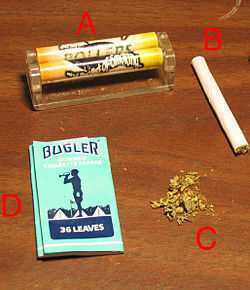Rolling machine

A rolling machine is a machine that is designed to roll either tobacco, cannabis, or other products such as synthetic cannabis into individual cigarettes or joints. To roll a cigarette with cannabis, one must break up the smoking material, which can be done using a grinder, as well as remove any stems so they won't puncture the paper. Rolling a cigarette with tobacco does not require prep work because the leaf is already shredded.
Once the material is ready, one opens up the rolling machine by sliding one of the rollers up and over; this exposes a channel where the material is loaded. Care must be taken to place a uniform amount of product in the channel or the burn rate will change as the cigarette or joint is smoked. When ready the roller is slid back into position and locks into place. The product is cradled and confined in a round space and gets rolled when the user begins to turn one of the rollers.
After a few turns, a single sheet of rolling paper is fed into the back of the channel with the "ungummed" side going in first. When rolled carefully the paper will make a complete revolution in the channel and will wrap around and under itself. At this point the user licks the gummed part of the rolling paper and continues to roll the rest of the rolling paper in. When the roller is moved out of position once again a perfectly rolled cigarette or joint is exposed.
Rolling machines come in different sizes to prepare different sized cigarettes or joints. Generally, the smallest is a 70mm, followed by a 78mm, and the largest being a 100mm.
Another type of rolling machine, manufactured by at least one company, is less commonly seen, but easier to use than the dual-wheel variety. In a "rolling box", a belt of material is exposed by opening the rolling box. The lower portion of the belt can be expanded against a curved tray component, and the tray filled with the material that one wishes to roll a cigarette or joint out of. A piece of rolling paper is then placed behind the material, against the belt material, with the gummed side at the top and facing outwards. As the box is slowly closed, a bar lifts the belt material up against the material to be rolled, simultaneously pressing it against the rolling paper and packing it more tightly, and also causing the portion of the belt with the lower edge of the rolling paper to roll around outwards, forming the cigarette or joint. When the closing motion is complete, the finished cigarette or joint is ejected through a hole in the top of the box.